Slade's Morgue:
Cutthroat


The Warlord in CUTTHROAT

A VENERABLE ORANG-OUTANG,
a caricature of Charles Darwin in THE HORNET, 1871
CUTTHROAT is Michael Slade's Darwinian monster thriller. Of all the Slade novels, it's the most unconventional. Here's the story behind it.
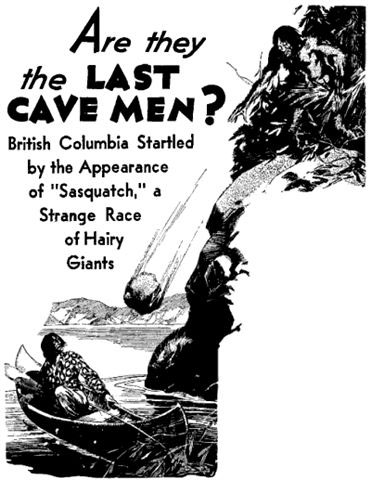
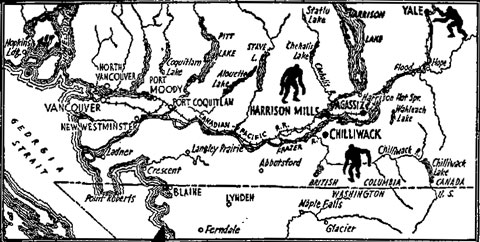
Two illustrations from THE LINCOLN STAR (Nebraska), July 29, 1934
British Columbia is Sasquatch country. B.C. has the wilds, the mountains, the climate, and the legends to support Bigfoot. Wild Man stories of giant, hairy, apelike creatures, cannibals, and monsters were rife among the totem tribes of the Pacific Northwest when colonial settlers arrived. For instance, the Kwakiutl (Kwakwaka'wakw people) describe Dzunukwa, or Cannibal Woman, as a dangerous monster. Twice the height of a human, with a black, hairy body and sagging breasts, she lurks in the forest and eats children.

The Kwakiutl of British Columbia (early 1900s)

Shaman of the Hamatsa cannibal cult

Hamatsa

Totem pole with Dzunukwa (Cannibal Woman) in the center (1881)
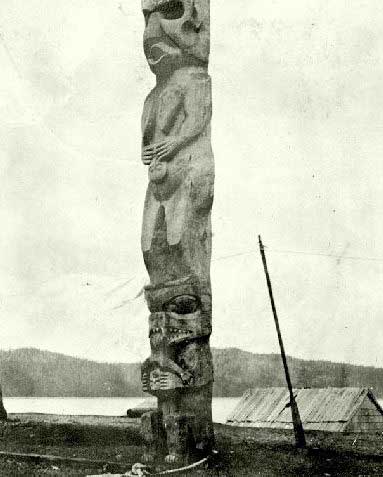
Totem pole with Dzunukwa (1914)
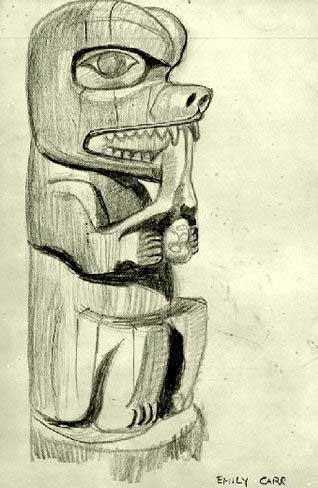
Dzunukwa by Emily Carr (1928)

Dzunukwa by Emily Carr (1930)
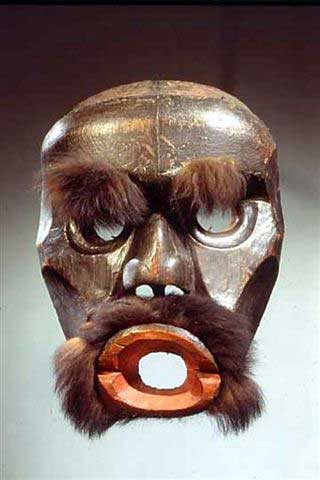
Dzunukwa (Cannibal Woman) Mask (1800s)
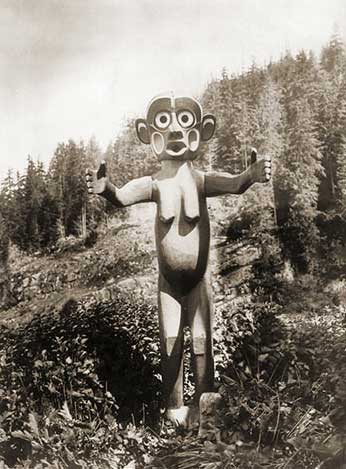
Dzunukwa totem

Dzunukwa by Emily Carr (1930)
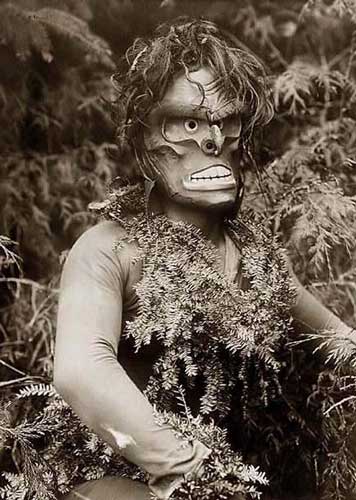
Paqus, Wild Man of the Woods
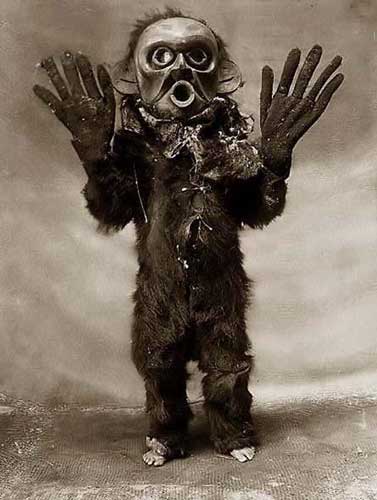
Hami, Dangerous Thing
John W. Burns was a government Indian agent and teacher on the Chehalis Reserve near Harrison, British Columbia, 60 miles east of Vancouver (see map above). In the 1920s, Burns wrote a series of newspaper stories about Native encounters with "hairy giants" and "wild men." By mispronouncing the Indian word "sásq'ets", he coined the name "Sasquatch." The name "Bigfoot" entered the lexicon of cryptozoology in 1958 when the HUMBOLDT TIMES of Northern California reported the finding of huge footprints in Bluff Creek Valley.
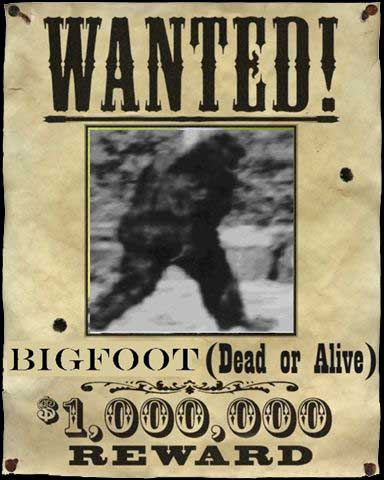
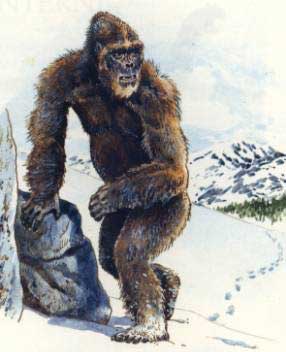
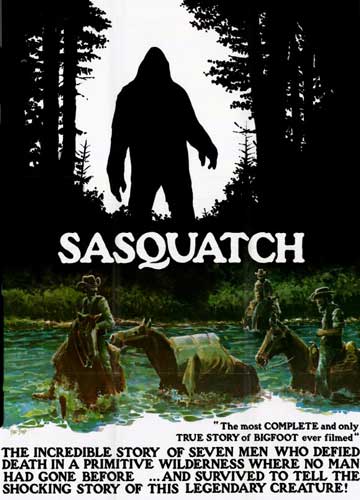
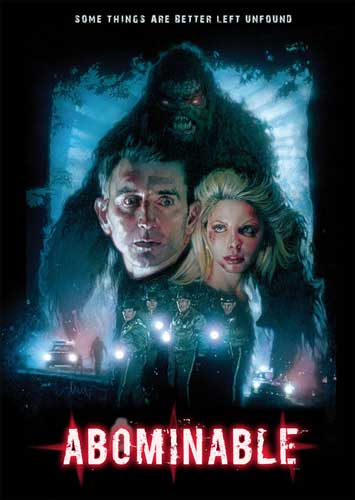

One by one, the post-1957 "sightings" of Bigfoot have been exposed as hoaxes, including the footprints that generated the name "Bigfoot" and the 1967 Patterson-Gimlin film shot at Bluff Creek.

Patterson-Gimlin film
British Columbia, however, remains genuine Sasquatch country, thanks to the totem evidence and oral history that predates colonization. You'll find Sasquatch Provincial Park near Harrison, where John W. Burns coined the name. Quatchi was a mascot of the 2010 Vancouver-Whistler Winter Olympic Games (see RED SNOW).

Quatchi
There's even a Canadian stamp.
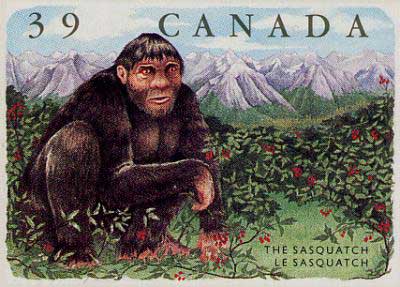
Tales of terror can be subdivided several ways. Wet vs. dry. Terror from without vs. terror from within. Slade prefers grand guignol macabre vs. the supernatural. The supernatural involves an objective break with reality. Grand guignol macabre has roots in real life, but a subjective break with reality cracks the human mind. It's the difference between Bram Stoker's DRACULA and Robert Bloch's PSYCHO. The Special X novels are grand guignol macabre. So how could Slade plot a Sasquatch thriller from real-life evidence?

North American edition of CUTTHROAT

In 1876, naturalist Francis Parker makes an extraordinary discovery before losing his life - and the evidence - in the horrific carnage of the Little Bighorn. In 1987, Judge Hutton Murdoch is addressing the American Bar Association in San Francisco when his brain is blown apart by a high-velocity bullet. Two days later, a Vancouver judge is pondering a complex point of law when a masked intruder slits his throat from ear to ear. The hunt for an ingenious killer soon becomes a desperate search for the missing link between these apparently unconnected events. A search that will lead to a corporate octopus engaged in bizarre genetic experiments, a sinister Chinese family with a centuries-old obsession, and ultimately to the secret of man's earliest beginnings. From the darkest depths of the past to today's highest tech, from Custer's Last Stand to China's Forbidden City, a cold-blooded assassin lures the Royal Canadian Mounted Police and the FBI up into the ice-capped Rockies for a showdown with Sasquatch.

"CUTTHROAT is Slade's most ambitious novel. It takes on big things like evolution and aging, spans three continents, and covers more than a century's worth of history. The novel is horror/fantasy played on an epic scale, yet loses none of its immediate impact. Slade pulls no punches when it comes to the killings. But the main draw is the mystery. CUTTHROAT gives a jolt to the serial killer genre." - Fangoria
"Hi-octane horror. A stunning chiller which mixes Custer's Last Stand with sinister Chinese longevity experiments and the Bigfoot legend. Twisted psychopaths and muscular prose. CUTTHROAT made me a committed Sladist." - Book Magazine
"Some of the most chilling murder-suspense-horror-cop procedural prose ever to stain paper. CUTTHROAT is a fascinating story about the mysteries of evolution, with dead-on-the-money detail and accuracy." - Calgary Herald
"Snap, crackle, perp. The plotting is meticulous. What I like most about Slade's books are their excursions into history, the fruit of much respectable research. In CUTTHROAT, you learn about the Mounties, evolution, X-rays, Chinese emigration, the coelacanth, and the myriad wonders of Vancouver. Sonnet 29 is thrown in, gratis." - The Observer (London)

"Thriller addicts have something different in CUTTHROAT. Through many twists and turns, we are led to some nasty scientific experiments and a sinister Chinese family. Compulsively exciting, intriguingly complex, and impossible to put down." - Today (London)
"Cut-'em-up, shoot-'em-up globetrotting." - B.C. Bookworld
"Scare me!, was the challenge from one hardened judge. The result: CUTTHROAT." - The Vancouver Sun
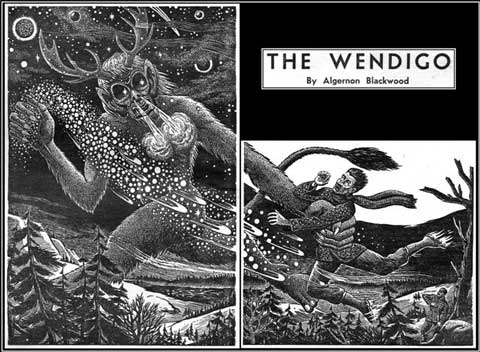
Illustration by Matt Fox in FAMOUS FANTASTIC MYSTERIES
East of the Rocky Mountains is Windigo (Wendigo) country. Akin to a Sasquatch crossbred with a werewolf, the Windigo is a malevolent mythological creature with a ravenous appetite for human flesh. The more it eats, the hungrier it gets. Strongly associated with winter and the North, this cannibalistic monster preys on Native people across the Prairies from the foothills of the Rockies to the woodlands of Quebec. The Cree describe it as a hairy giant, many times larger than man, with a huge head and gnashing fangs in a twisted mouth. The name derives from "witiku": the Algonkian word for "evil spirit" and "cannibal." First mention of the name in English was in 1743, when trader James Isham recorded the beliefs of the Cree he met at Hudson's Bay.

Wendigo by Marvel Comics
(fair use of single copyrighted image from widely marketed comic to discuss historical context of ongoing mythological creature and its overall influence on author)

Wendigo mini-bust by Tim Bruckner
The Windigo, however, poses another threat. A Cree who resorts to cannibalism can turn into the monster. Alternatively, the demonic spirit of a Windigo can possess a Cree, and transform him into a terrifying flesh-eating maniac with superhuman strength.

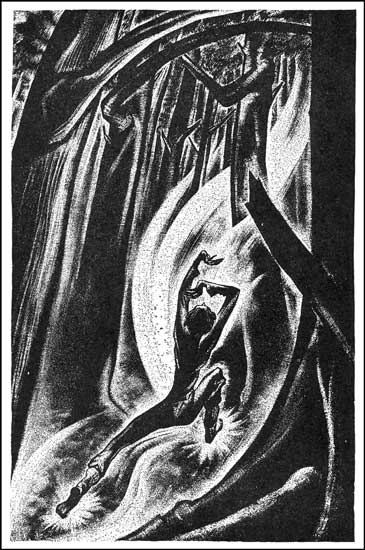
Illustrations by Lynd Ward for Blackwood's 1910 story in HAUNTED OMNIBUS
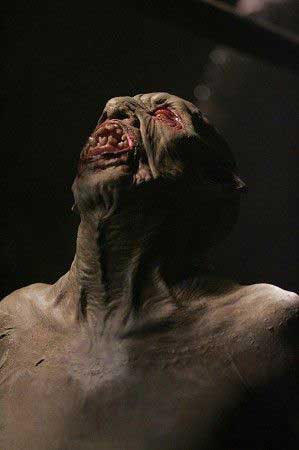
SUPERNATURAL's Windigo
So strong is the dread of Windigo possession among the Cree that it can result in a recognized culture-bound mental illness. Those who suffer the syndrome of "windigo psychosis" develop an insatiable craving to eat human flesh and fear they are morphing into the cannibal monster.
In 1879, a Cree trapper named Swift Runner was hanged at Fort Saskatchewan for killing, butchering, and eating his family. At the cannibal's camp in the woods northeast of what is now Edmonton, Alberta, the Mounted Police found the remains - bits of flesh, hair, and bones cracked open for their marrow - of the Cree's wife, six children, mother, and brother. He suffered screaming fits in his sleep, and said he was possessed by the Windigo.

Swift Runner (Library and Archives Canada)
Jack Fiddler (or Zhauwuno-geezhigo-gaubow, "He Who Stands in the Southern Sky") was an Ojibwa shaman known for his ability to defeat the Windigo. Legend says he succeeded 14 times. In 1907, the Mounties arrested him for the murder of a woman possessed by the monster. Before he could stand trial, the Native "Van Helsing" hanged himself.
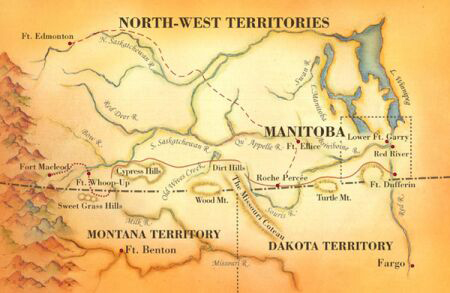
Windigo country (from RCMP: THE MARCH WEST)
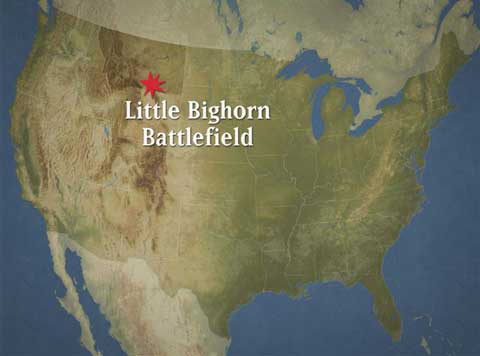
South of the Medicine Line
As detailed in BIO and HEADHUNTER, Slade lived his first eight years (1947 - 1955) in Windigo country, along the route of the Mounties' historic 800-mile March West of 1874 from Manitoba to the Rocky Mountains. From his extended pioneer family dating back to Fort Calgary in 1883, where his great-grandfather - the "Leather Man" - lived among the Blackfoot and the Cree, young Slade heard the myth of the Windigo, and the story of "Sitting Bull's Boss" in the aftermath of Custer's Last Stand. He also trekked the Dinosaur Valley of Alberta's Badlands, and camped in the Rocky Mountain parks of Jasper and Banff. Then, in 1955, Slade moved west from the Prairies across the Great Divide to Sasquatch country, where he heard the monster myths of his current home.
The 1950s were fertile years for a boy's imagination. The atomic bombings of Hiroshima and Nagasaki (see KAMIKAZE), combined with the Cold War threat of nuclear devastation, filled the theaters with films about mutant monsters. Such horrors, they blared, were caused by "atoms gone wild!" And for Slade, the movie that captured mutation best was THE FLY.

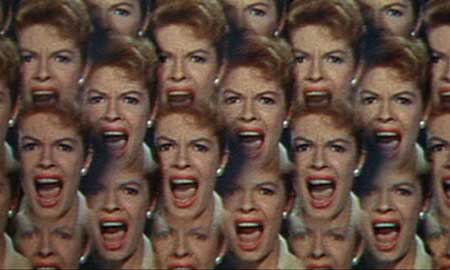
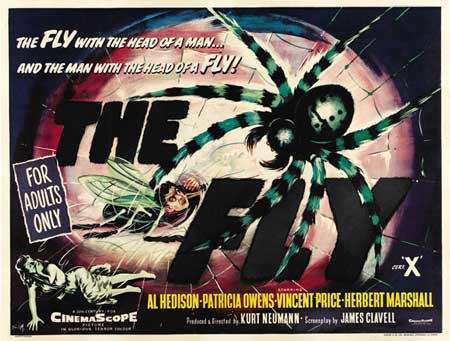
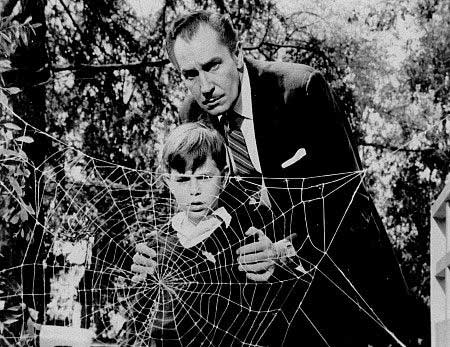
"Help me! Help me!"
Meanwhile, in the real world, science saw thrilling discoveries. In 1953, James Watson and Francis Crick mapped their double helix model of DNA, the key to explaining "atoms gone wild."

Watson, Crick, and DNA
In 1959, after decades of hunting in Africa's Olduvai Gorge, Louis and Mary Leakey unearthed the first hominid fossils. Here was Charles Darwin's "Missing Link": the genesis of human evolution.
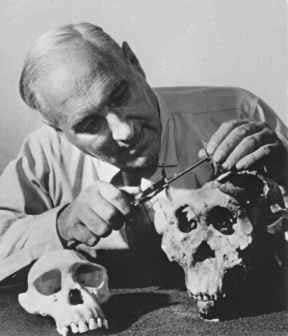
Louis Leakey examining skulls from the Olduvai Gorge

The Olduvai Gorge of Kenya and Tanzania from space
The decade ended with 1960's THE TIME MACHINE. Genetic mutation from nuclear war has split human DNA into two subspecies. The Eloi live on the surface. The Morlocks live underground. Not only are the Morlocks cannibals, but they looked like how young Slade imagined the Sasquatch and Windigo did.

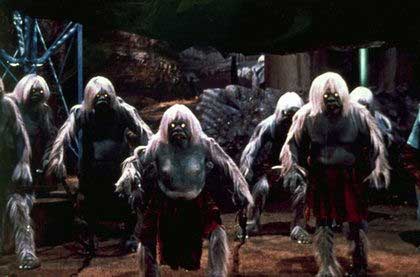
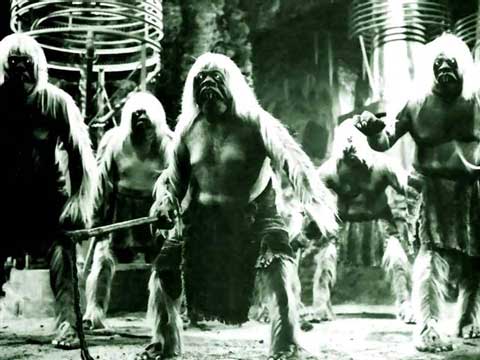
Every Slade thriller spawns from his boyhood interests (amply illustrated by the various MORGUE drawers), mutated by knowledge and incidents gathered in the ensuing years. CUTTHROAT grew out of the interconnected inspirations above. The novel opens at Custer's Last Stand.


CUSTER'S LAST STAND
by Edgar S. Paxson

CUSTER'S LAST STAND (Detail)

BATTLE AT LAST STAND HILL
(National Park Service)

BATTLE OF THE LITTLE BIGHORN
by Charles M. Russell

CUSTER'S LAST BATTLE
by Elk Eber

CUSTER'S LAST RALLY
by John Mulvaney

CUSTER'S LAST CHARGE
(Library of Congress)

BATTLE OF THE BIG HORN
(Library of Congress)

U.S. ARMY - CUSTER MASSACRE AT BIG HORN
(Library of Congress)

GENERAL CUSTER'S DEATH STRUGGLE
by H. Steinegger

CUSTER'S LAST FIGHT

CUSTER'S LAST FIGHT
by Alfred Waud

CUSTER'S LAST FIGHT by Otto Becker.
One of the most famous pictures in America,
thanks to widespread promotion by Anheuser-Busch
(Budweiser: "This Bud's for you...")

CUSTER'S LAST FIGHT (Detail)

CUSTER'S LAST FIGHT (Detail)

GREASY GRASS, a Lakota drawing

Drawing from the HALF MOON LEDGER

Custer

Sitting Bull

Rain-in-the-Face. Legend is that
he killed Custer and cut the heart out
of his brother, Tom Custer.
Custer's Last Stand is the most famous incident of America's Wild West. Everyone knows the basics of the Battle of the Little Bighorn depicted in the many artworks above. But do you know the story behind what caused the confrontation? The prequel of two discoveries made on Indian land?
The Treaty of Fort Laramie (1868) granted the Sioux exclusive ownership of their sacred Black Hills. The discovery of gold soon trumped that. Custer was ordered to drive the Sioux out of their territory. On June 25, 1876 - a brutally hot day - he led the 7th Cavalry in a thundering, ill-conceived attack on Sitting Bull's camp near the Little Bighorn River, and got the surprise of his life.

Note the Black Hills within the Great Sioux Reservation
Gold, however, wasn't the only treasure in the Black Hills. The first known American dinosaur was unearthed in New Jersey in 1858. The dinosaur mania that set off culminated in a fierce rivalry - the Bone Wars, or "Great Dinosaur Rush" - between Professor Othniel Charles Marsh of the Peabody Museum of Natural History at Yale...

Marsh
...and Edward Drinker Cope of the Academy of Natural Sciences in Philadelphia.

Cope
The two men hated each other. Their animosity raged through the bone beds of Kansas, Nebraska, Wyoming, and Colorado. They tried to out-compete each other in the field through bribery, theft, and dynamiting rival fossil digs. At home, each tried to ruin the other's credibility in scientific publications as a ploy to cut off funding.
In the 1870s, the feud focused on the Black Hills of Dakota. Marsh had met Darwin in England, and hoped to find fossil support for his inflammatory theory of evolution. While leading an expedition that plundered the Black Hills, Marsh barely escaped from some angry Sioux. But not before he carted out tons of dinosaur bones.

Expedition: Marsh and his armed assistants, 1872

Expedition: The bone hunters rile some natives
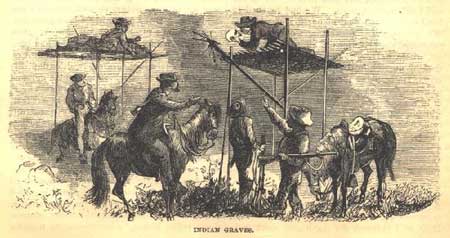
Expedition: Respect for Indian graves. HARPER'S MAGAZINE
has Marsh say, "Well, boys, perhaps they died of
small-pox; but we can't study the origin of the Indian
race unless we have those skulls!"
In the end, Marsh won the Bone Wars. He discovered 80 dinosaur types to Cope's 56. Cope tried to extend their feud beyond the grave. Brain size, it was thought, determined intelligence, so he asked that his head be dissected after death, and challenged Marsh to do the same. Marsh declined, and Cope's head is still at the University of Pennsylvania.

Marsh and Cope war over bones after death
What sparked Slade's imagination was the plot potential of this. In 1874, Custer asked Marsh to join his campaign in the Black Hills as a naturalist. Instead, Marsh sent George Grinnell, his student at Yale and assistant on digs in the West. Later, Custer asked Grinnell to join his 1876 campaign, but the naturalist, fortuitously, had another commitment.
But what if...?
What if a Darwinian student of Professor O.C. Marsh, hoping to make a name for himself in paleontology, ventured alone into the Black Hills to see what he could find? What if that bone hunter, Francis Parker, was forced to run for his life by hostile Sioux, and encountered the 7th Cavalry just before its fatal charge? And what if he got embroiled in Custer's Last Stand?

Note the words "Terry-Custer Column" on the map above. Terry and Custer had split up before the Last Stand. Two days after the annihilation at the Little Bighorn, Terry's troops found the battlefield. What if Captain Jericho Sharpe - assigned the task of gathering evidence while others buried the bodies - picked up Francis Parker's notebook dropped in the sage. What if Sharpe was a Bible-thumping Christian, a military creationist whose God-given place in the universe was threatened by Darwin's blasphemous theory of evolution? And what if what Parker had discovered in the Black Hills and analyzed in his notebook - the yellow skull that left the battlefield hoisted on White Owl's lance - was advanced as fossil proof of Darwin's heresy akin to this:
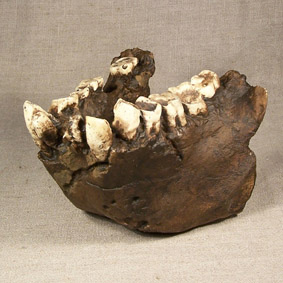
What a monkey wrench Charles Darwin threw into the Christian religion. Based on a literal interpretation of the Bible's timeline, God created Adam and Eve around 4000 B.C. Scripture says it all began in the Garden of Eden. God forbade Adam, the first man, to eat the fruit of the tree of the knowledge of good and evil. The serpent - Satan in disguise - persuaded Eve, the first woman, to eat from the tree and share the fruit with Adam. After he took a bite, Adam became aware of his nakedness. By his sin, Adam lost the original holiness and justice he had received from God, not only for himself, but for all mankind. God expelled his creations from Eden, and cursed Eve by commanding Adam to rule over her. Adam and Eve's polluted human nature passed down through their descendants. As a result of Original Sin, all human beings are subject to ignorance, suffering, domination of death, and the inherent inclination to sin.
The New Testament says that's why God sent his only son, Jesus, as the messiah. Christ's crucifixion was for Man's salvation, and only through belief in him can humans wash away the taint of Original Sin.
Darwin burst into the Christian religion like an anarchist with a bomb. His ON THE ORIGIN OF SPECIES (1859) and THE DESCENT OF MAN (1871) theorized that human beings evolved from apes through natural selection. For those who believed in the literal interpretation of the Bible, the threat to social order could not be greater. Without Adam and Eve and mankind's fall from paradise into ongoing sin and death, Christ became a messiah without a mission. There was nothing to redeem mankind from.
In Darwin, true believers had a "mutant monster" in their midst.

Note the words "I think" above Darwin's first evolutionary tree, drawn in his notebook in 1837

Caricature of Darwin by Andre Gill, 1867

Thomas Nast Cartoon, 1871. The gorilla says, "That man wants to claim my pedigree. He says he is one of my descendants." The founder of the Society for the Prevention of Cruelty to Animals replies: "Now, Mr. Darwin, how could you insult him so?"

That Troubles Our Monkey Again. FUN, 1872

Caricature of Darwin in the LONDON SKETCHBOOK, 1874

Caricature of Darwin on the cover of LA PETITE LUNE, Paris, 1880s

Man Is But A Worm. Caricature of Darwin, PUNCH, 1882
The Scopes Monkey Trial is one of Slade's favorite courtroom battles. Tennessee law made it illegal "to teach any theory that denies the story of divine creation as taught by the Bible and to teach instead that man was descended from a lower order of animals." In the sweltering heat of July 1925, high school biology teacher John Scopes stood trial in Dayton, Tennessee for unlawfully teaching Darwin's theory.

John Scopes
He was prosecuted by William Jennings Bryan, a three-time candidate for U.S. President. Called the "Great Commoner," Bryan had long waged a creationist's crusade to ban Darwin's theory from American classrooms.

THE DETROIT NEWS, 1909
Scopes was defended by Clarence Darrow, America's most famous trial attorney.

Darrow and Bryan at the Scopes Monkey Trial
So many people crammed into court that the judge feared the floor would collapse. When the temperature rose above 100 degrees, the trial was moved outside. That set the stage for what THE NEW YORK TIMES called "the most amazing court scene in Anglo-Saxon history." Darrow called Bryan to the stand to be cross-examined as an expert on the Bible.
Darrow hammered Bryan about the whale swallowing Jonah, Joshua making the sun stand still, Noah and the great flood, Eve being made from Adam's rib, and the creation according to Genesis. Bryan stumbled badly, and at one point blurted out, "I do not think about things I do not think about." Darrow shot back, "Do you think about the things you do think about?"
Scopes was convicted. Bryan died six days later. The conviction was quashed on appeal.

Cartoon about Bryan in the SUN on the day the trial ended
Even though evolution is now conclusively proved by hominid fossils and DNA, the battle between creationists and Darwin continues today. In 1876, however, no fossils had been found, except some bones in Germany's Neanderthal Valley in 1856. Skeptics dismissed Neanderthal Man as "an idiot with rickets or water on the brain;" "a Cossack who perished during Napoleon's retreat from Moscow;" "an old Dutchman or a relic of the Celtic race;" and "a freak like those on display at every carnival."
So what would God-fearing creationists do if they found evidence supporting evolution and no one else knew? Dispatch General Gideon Pratt to England to interview Darwin, and if the heretic had no inkling of Francis Parker's find, suppress the battlefield notebook?
And what about White Owl, the yellow skull, and Parker's Journal in the shoulder bag?
If you were Sitting Bull and had just annihilated Custer's 7th Cavalry, how would you protect your people from bloody revenge by the U.S. Army? You'd lead the Sioux north across the Medicine Line to the realm of Queen Victoria, the Great White Mother. Why? Because during the American Revolution, the Sioux fought with the Redcoats against the revolutionaries, and had medals from King George to seal friendship between them and the Crown. By treaty, the U.S. cavalry couldn't chase the Sioux across the border.

Sitting Bull (top oval) crosses into Canada near Fort Walsh
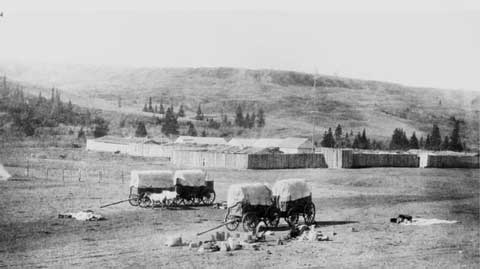
Fort Walsh


Mountie and Indian
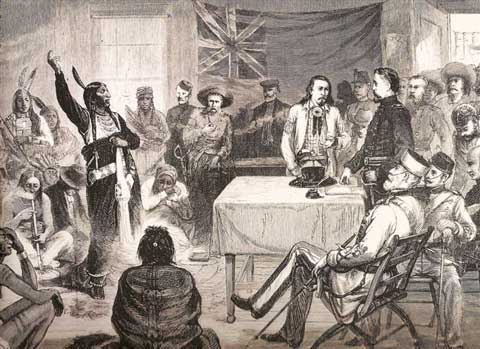
Sitting Bull at Fort Walsh
As did the prequel, the sequel to Custer's Last Stand inspired CUTTHROAT. The myth of the Mounted Police was forged by their dealings with the retreating Sioux. The Mountie who faced down Sitting Bull was Superintendent James "Bub" Walsh. He was the epitome of the "thin red line," an Imperial guardian whose stance among the plains tribes saw one hand on his hip and the other on the pommel of his cavalry sword. If you think the Mounties look resplendent in their red serge uniforms, that was simply working garb to Walsh.
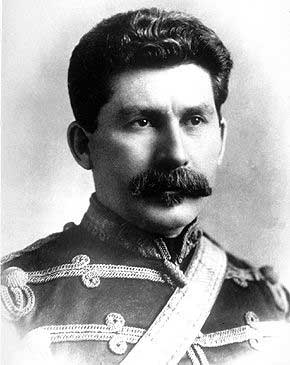
Walsh
Here he is dressed up.
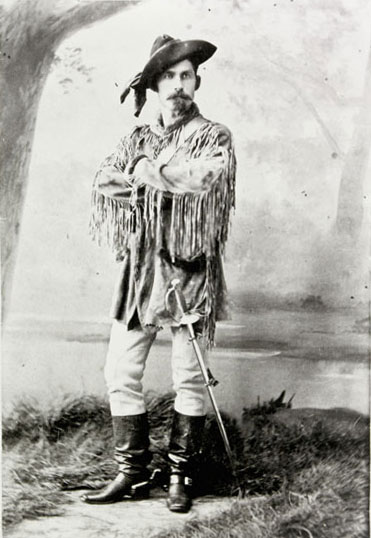
Walsh as Imperial cowboy
In 1877, the "mocassin telegraph" brought word that Sitting Bull was camped near the Pinto Horse Buttes. Not four years into existence, the Mounted Police had their greatest threat. The Sioux had enemies among the northern tribes. The buffalo herds were dwindling. And what if the American refugees used Canada as a base to raid the U.S. Army? So it fell to Walsh to lay down the law.
On May 28, Walsh, four Mountie lancers, and two scouts rode into Sitting Bull's camp. Several thousand strong, the Sioux warriors wore scalps and uniform trophies from Custer's Last Stand. When Sitting Bull promised to keep the peace, Walsh saw an opportunity to exert authority by arresting White Dog, a Canadian Assiniboine in the Sioux camp, for riding a stolen horse.
You can imagine what the American press did with that. Walsh was dubbed "Sitting Bull's Boss." The Fort Benton, Montana Record claimed "The Mounted Police don't scare worth a cent." And soon the newspaper catch phrase became "The Mounties always get their man!"
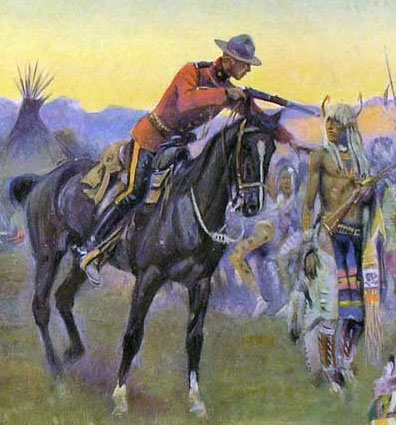
SINGLE HANDED (detail) by Charles M. Russell

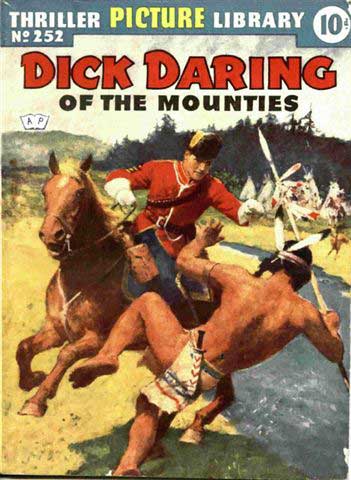
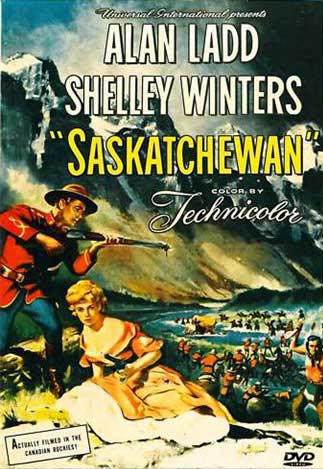

"...where the Royal Northwest Mounted Police stood alone against the fury of the Custer-massacring Sioux and the savage Cree nation!"
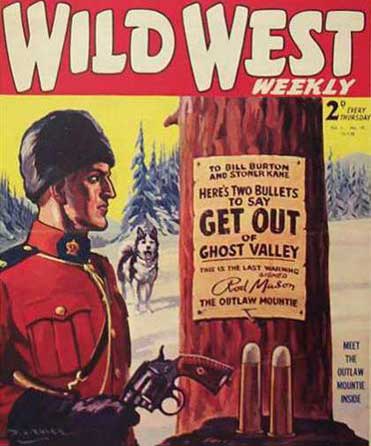
Note "The Outlaw Mountie"

Chased up into the Rockies
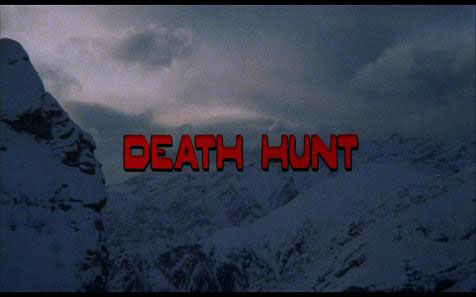

Lee Marvin as a Mountie in DEATH HUNT
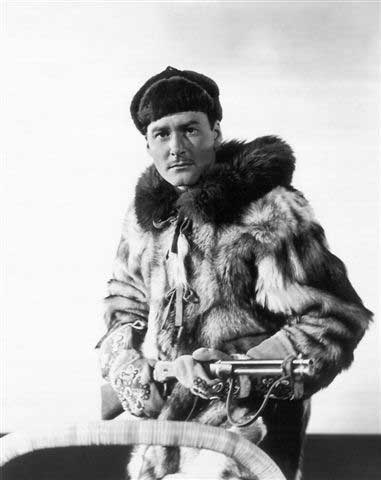
Errol Flynn as a Mountie in NORTHERN PURSUIT
Here was the ideal historical setup for Slade's Darwinian thriller. White Dog, the Assiniboine, became White Owl, the Cree. Like the militant creationists in the U.S. Army, the warrior feels driven to keep his fossil find a secret. Entrusted to him is a powerful spiritual "medicine," for surely the battlefield talisman is the skull of the mythic cannibal monster, the dreaded Windigo. Unluckily for him, however, the Horseman who Walsh has arrest the Cree is the Mad Mountie from HEADHUNTER, Inspector Wilfred Blake.
Blake is Slade's fictional twist on the motto "The Mounties always get their man." Unknown to his superiors, the inspector's a psychotic trophy hunter. When there's a need for tracking, Blake's the Mountie dispatched alone into the wilderness to hunt down the fugitive and bring him back dead or alive. The trophy Blake seizes from White Owl is Parker's Journal. And twenty years later, in the aftermath of Almighty Voice's last stand, he goes after the yellow skull by chasing Iron-child, White Owl's son, across the Prairies and up into the Rockies near Windigo Mountain.
There, Blake vanishes, never to return.
The Mad Mountie kept his secrets in a false-bottomed trunk. For a century after the Lost Patrol, history knew nothing of the yellow skull. Not until Parker's Journal was found by Chief Superintendent Robert DeClercq, and revealed to the world in his book on Blake, BAGPIPES, BLOOD, AND GLORY.
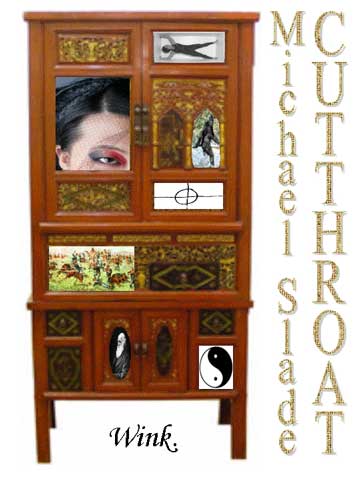
When young Slade moved to Vancouver in 1955, the totem tribes weren't the only culture that enthralled him. There was Chinatown.

Vancouver's Chinatown in the 1960s


At 4' 11", the Sam Kee Building (1913) is the narrowest commercial building in the world

Note the Chinese medicine shop at street level
Between 1881 and 1885, Canada imported 15,000 "coolies" to build the national railway through B.C.'s rugged mountains. It cost a Chinese life for every quarter-mile. When white bosses reneged on paying the return fare, the stranded Asians settled in Shanghai Alley, which grew into Chinatown.
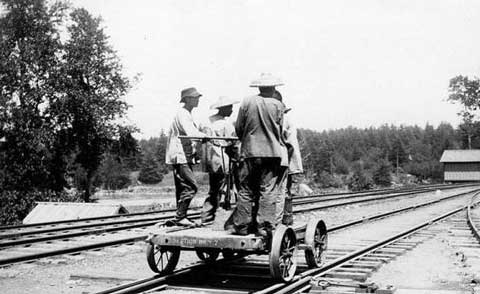
Chinese workers building the Canadian Pacific Railway

Chinatown street, 1904 (Vancouver Historical Society)

Canton Alley
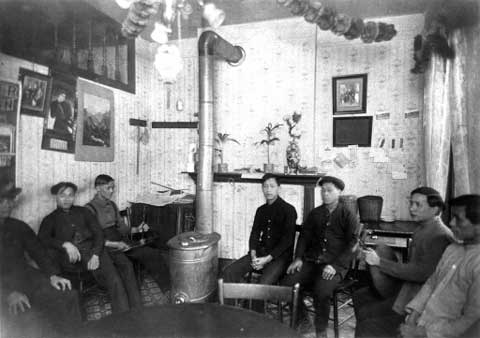
Chinatown rooming house, 1902 (B.C. Archives)
Vancouver's Chinatown is North America's second largest. That spawned xenophobic fear of the "yellow peril," and in 1907, a rally by the Asiatic Exclusion League turned into a riot. A mob 5,000 strong stormed through Chinatown, smashing property. The aftermath was 1923's Exclusion Act.

The 1907 Riot
The archetype of the evil Chinese supervillain is Dr. Fu Manchu. He appeared in a series of novels by Sax Rohmer, published between 1913 and 1959. He's the Asian equivalent of the archnemesis of Sherlock Holmes, Professor Moriarty. In a 1958 conversation broadcast on the BBC, Raymond Chandler asked Ian Fleming, the author of DR. NO, why there is always a torture scene in every James Bond novel. Fleming replied, "Well, you see, I suppose I was brought up on Dr. Fu Manchu and thrillers of that kind."
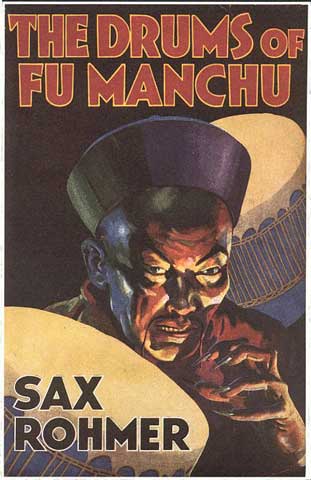
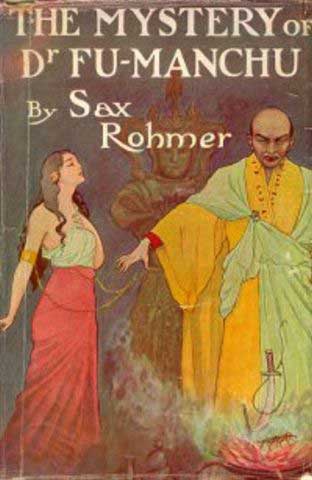
The first Fu Manchu book (1913)
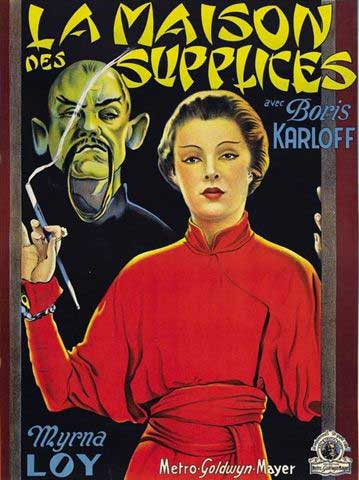
Boris Karloff as Fu Manchu (1932)

THE MASK OF FU MANCHU (1932)

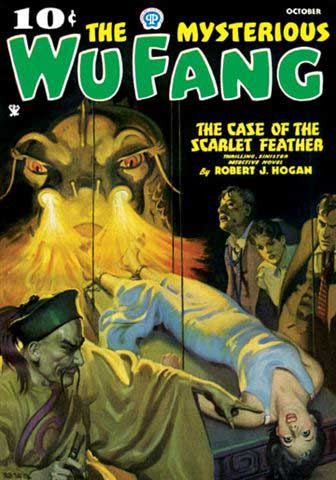
A rival of Fu Manchu (1935)

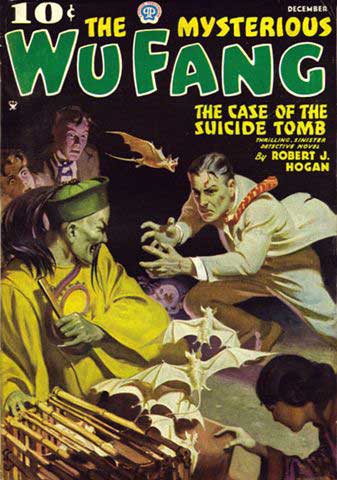
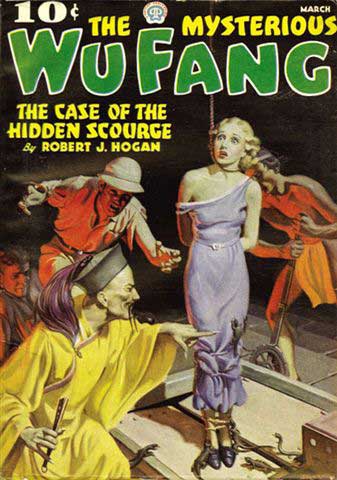
WU FANG covers by Jerome Rozen

Another rival, YELLOW CLAW (1956), cover by Joe Maneely
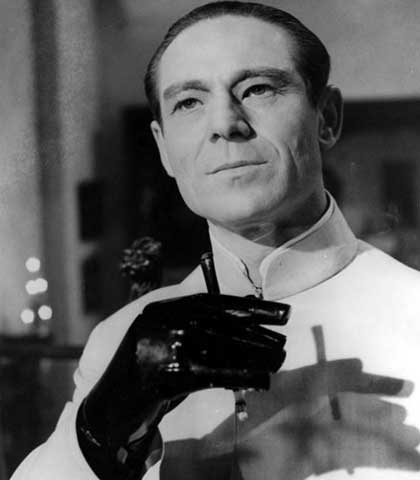
Joseph Wiseman in DR. NO

Christopher Lee as Fu Manchu (1968)
Slade's first trip to Chinatown was when he was nine. He sat in the back of his best friend's parents' car and learned how to use chopsticks. They ate at the Ho Inn. The food was delicious. But some of the items on the menu were strange indeed, like bird's nest soup. There was a bird's nest in Slade's back yard. Why would anyone want to eat twigs? The bill for dinner was calculated by an abacus with beads.
Treks through Chinatown became exotic adventures. Lots of gambling glimpsed through cracked doors, and Slade was sure he could smell opium smoke. Soon he was reading every thriller tied to China. Fu Manchu, of course. But also Robert Van Gulik's Judge Dee.
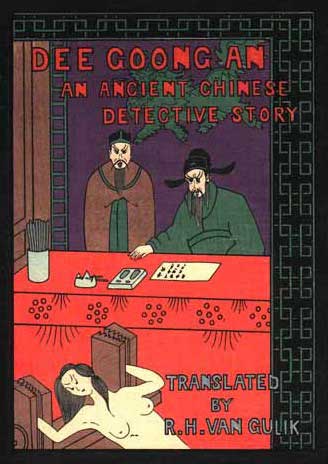
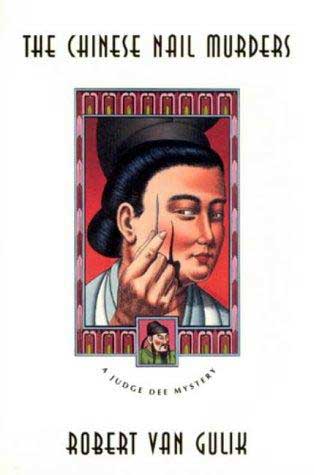

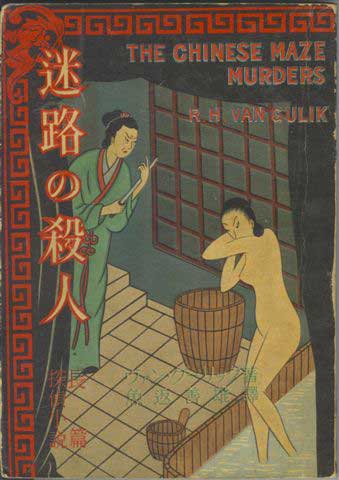
As an undergrad, Slade studied the history of China at university. Here, too, was the ideal setup for plotting CUTTHROAT.
In the 1800s - no surprise - the British were lovers of tea. Thirty million pounds of Chinese tea by 1830. That's two pounds of leaves for every Briton. To pay for it, the Crown exported opium from India. When China balked at creating a realm of addicts and confiscated 20,000 chests of "foreign mud," the First Opium War broke out. The British won and seized Hong Kong as a colony in 1841.
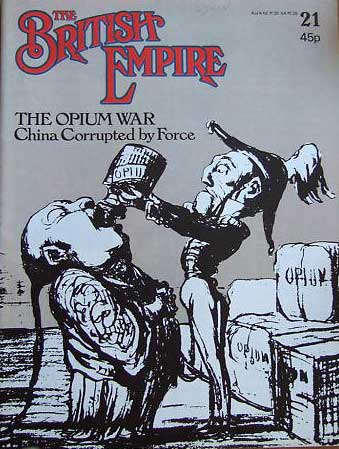

DESTROYING CHINESE WAR JUNKS by Edward Duncan (1843)
Imperial China dates from the Qin Dynasty in 221 B.C. to the fall of the Qing Dynasty in 1912. The first emperor, Qin Shi Huang, began the Great Wall of China and amassed the Terracotta Army.

Terracotta Army
Imperial China was the Middle Kingdom, the "Center of the World." The Ming Dynasty built the Forbidden City in Beijing as an imperial palace. It took more than a million workers fifteen years, from 1406 to 1420. The heart of the Forbidden City is the Hall of Supreme Harmony. No building in China could stand taller. The hall is dominated by the Dragon Throne. From it ruled a succession of fourteen Ming and ten Qing emperors.

The Forbidden City

The Hall of Supreme Harmony
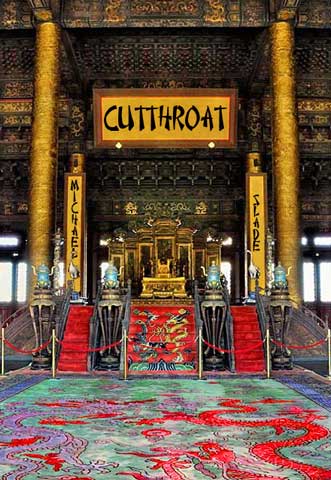
The Dragon Throne
Losing Hong Kong was the beginning of the end for Imperial China. "Barbarians" carved up the weakened Middle Kingdom.
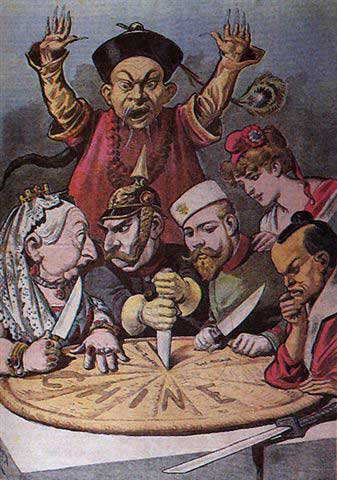
French cartoon
The fall of the Qing Dynasty in 1912 ushered in the turbulent Warlord Era. China was ruled by shifting coalitions of military strongmen who cut more than throats. In 1949, the Communists defeated the last Kuomintang warlords, and Mao Zedong (Mao Tse-Tung) proclaimed the People's Republic of China from the parapet of the Gate of Heavenly Peace, where his portrait hangs today, facing Tiananmen Square. To survive, the throat-cutting warlords fled to Taiwan or the British Colony of Hong Kong.


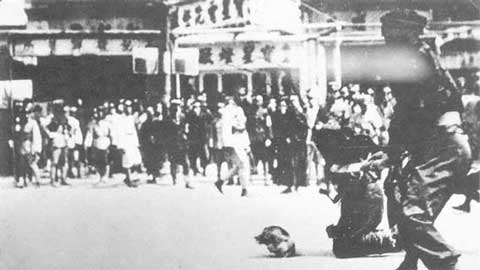
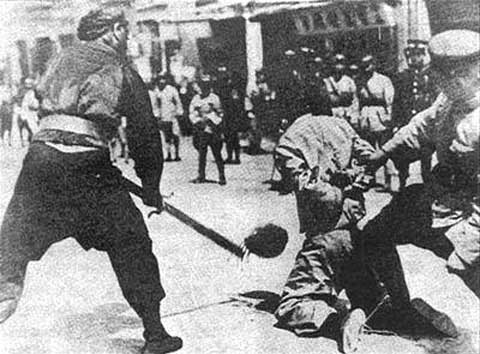


The Gate of Heavenly Peace
From 1972 on, Slade practiced law from his office on Maple Tree Square at the edge of Chinatown. The Provincial Courthouse - where every criminal case in Vancouver begins - was two blocks up the street. Consequently, Slade ate in Chinatown several times a week.

Slade's law office

Slade's office in 1931
By then, the food in Chinatown was far more exotic than nine-year-old Slade's first meal at the Ho Inn. And so were the eats available at traditional Chinese medicine shops.

Dried plants and animals for Chinese medicine: snake, turtle, ginseng...
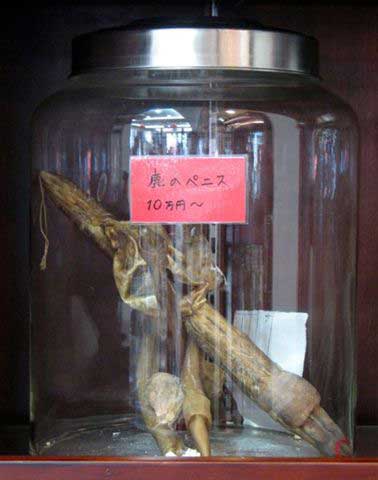
Deer penis (licensed copyright)

Bear gall bladder
Traditional Chinese medicine goes back more than 2,000 years. Zhang Zhongjing (Chang Chung-Ching) - the "Hippocrates of China" - practiced during the Han Dynasty (206 B.C. to 220 A.D.).

Zhang Zhongjing

Li Shizen (Li Shih-Chen) (1518 - 1593), the great healer of the Ming Dynasty, spent thirty years compiling THE GREAT COMPENDIUM OF HERBS. Li sought the secret of immortality.

Li Shizen

Traditional Chinese medicine balances yin and yang. Illness indicates an imbalance is under way. Since yin is all things negative, and yang is all things positive, illness moves from yang to yin. Yang medicines restore balance. And if they come from animal parts, wildness equals strength. The wilder the animal, the stronger the drug.

Yin and yang
By the 1980s, Hong Kong equaled capitalism gone wild. The place where money buys everything. When it was announced that Britain would hand the colony over to Communist China in 1997, a tidal wave of emigrants hit Vancouver. Canada sold citizenship for a quarter-million dollars, and a burgeoning market for animal yang medicated rich arrivals.
A Chinese tael is 1.3 ounces. Bear gall bladder for heart disease and cancer: $650 a tael. Elk and caribou antlers for fertility and general health: $550 a tael. Rhinoceros horn and tiger penis for sexual arousal and production of semen: $2,900 a tael and $1,800 each.
That got Slade thinking, "What would be the wildest animal yang of all?"

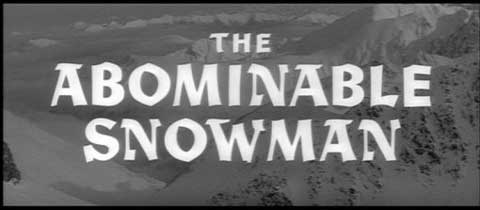

Maldives stamp

Bhutan stamp

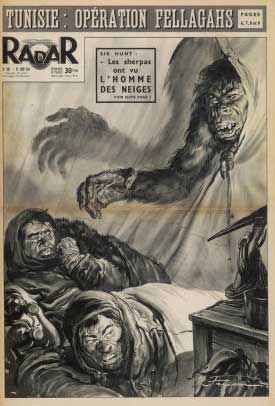
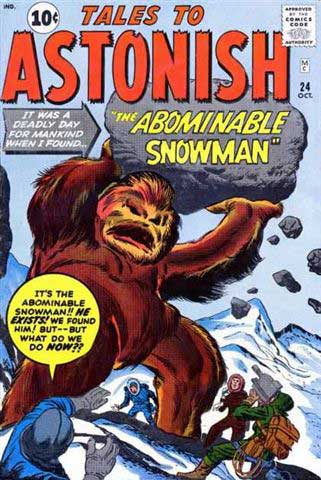
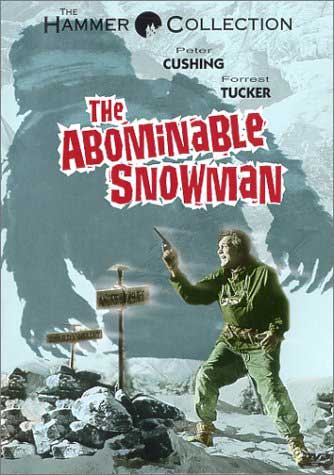
As with its North American cousins, the Sasquatch and the Windigo, tales of the Yeti predate Western intervention. Tibet's Bon religion sought Yeti blood for magic. Buddhist monks sought Yeti flesh as a general cure-all. While scaling the Himalayas in 1889, a British soldier spotted giant footprints at 17,000 feet. In conquering Mount Everest in 1953, Sir Edmund Hillary and Tenzing Norgay saw similar tracks. In 1979, under the headline "Soldiers Ate a Yeti," London's SUNDAY TELEGRAPH ran a story from the Chinese journal HUASHI (FOSSILS) that, in 1962, Himalayan troops killed a Snowman for its meat.
Hmmm, Slade thought. Yang?
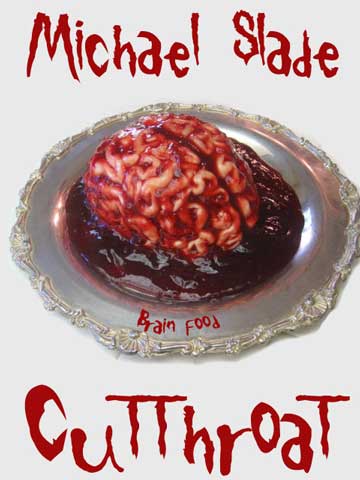
For 2,000 years, dating back to the Han Dynasty, "dragon teeth" - fossils - have been used as medicine. In 1935, a German scientist found a huge tooth in a Hong Kong drugstore. Though three times the size of a man's, the tooth had a human-like cusp pattern. Jaws of the new creature - Gigantopithecus - were later found in China. Where it stands in evolution is an unresolved mystery, but "Giganto" is the largest primate that ever lived. Fossil finds show it coexisted with Homo erectus, and possibly Homo sapiens.
Question: During the Ice Age, did Giganto cross the frozen land bridge from Asia to North America and leave the yellow skull in the Black Hills?

Gigantopithecus jaw
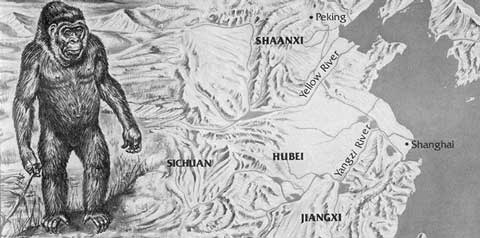
Giganto

With all the pieces to his jigsaw puzzle in mind, Slade flew to China and Hong Kong to research CUTTHROAT.
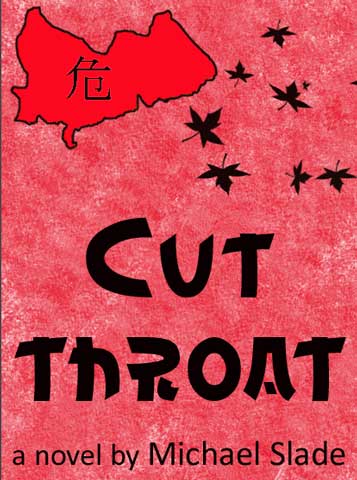

Slade sitting on the Great Wall of China, which snakes in the background
Yes, folks, he's back (see ZOMBIE/EVIL EYE and DEATH'S DOOR). The intrepid explorer? Or the damn fool?
The Great Wall of China is the longest structure ever built. It dates back 2,000 years to the Qin Dynasty. With all its branches, the Great Wall stretches for 5,500 miles (8,850 km). The distance from the East Coast of the U.S. to the West Coast averages 3,000 miles. Built with human labor and rudimentary tools, the Great Wall protected Imperial China from nomadic northern invaders, and roughly follows the southern edge of Inner Mongolia. To stand on the Wall is to grasp the power of the Dragon Throne.

Great Wall in the Qin Dynasty (red, with China's current border in yellow)
(Map by Ksyrie, licensed copyright)

Great Wall at Badaling thronged with tourists

Caged on the rampart
Standing on the Great Wall is, of course, an illusion. That's not the Great Wall. It's a reconstruction designed to keep tourists caged like cattle along the rampart.
Slade, however, will stop at nothing to give his readers (and himself) an "authentic experience." So when he noticed an old woman beckoning to him and pointing down over the side of the rampart, off he sidled. Gazing over, he spied a staircase of rocks piled up for free spirits like him. And by greasing the woman's palm with an American dollar, he made his great escape.

Slade's unchained melody
No Slade novel is plotted by sitting in a room. It comes together by living the story with a notebook, a camera, and a hand-held recorder. Reinforced by various dynasties up until the Ming, the Great Wall was finally breached by the Manchus in 1644. The invaders established the Qing Dynasty that fell in 1912.
The farther along the Wall he snaked, the deeper Slade fantasized...

The zigzag slither
This was the real Wall in all its crumbling ruins...

The dynasties trod these stones
Slade was really out there, with not a human in sight, when...

...his "snaking" turned real!
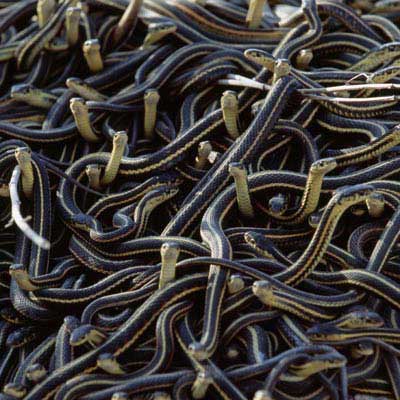
These aren't the actual snakes, but you get the idea. Snakes like nothing better than sun-warmed rocks with lots of cubbyholes in which to nest. Lost in his fantasizing, Slade had stepped into such a nest, and dozens...no hundreds...no thousands of snakes were now squirming around his feet.
The trouble with snakes in a foreign land is that you don't know what they are. Slade lives in a province of rattlers, but his fired-up imagination told him this was worse. These were undoubtedly the most venomous snakes on earth, both hemotoxic and neurotoxic in effect, and thanks to his intrepid quest for "authentic experience," there wasn't a soul within earshot.
If a Slade falls on the Great Wall and no one is around to hear him cry "Help!", does he make a sound?
The damn fool ran like hell for the safety of the rampart cage.

In the above photo of the Forbidden City's Hall of Supreme Harmony, note the gray swath ascending to the central door. Embossed dragons - see below - lead to the Dragon Throne.

In the Forbidden City, dragons are everywhere...
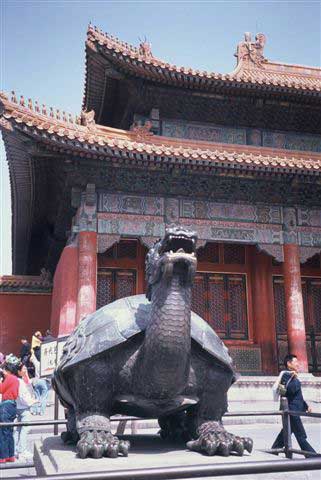
Half dragon, half turtle
And so are longevity symbols.

The crane - believed to be immortal - is a Chinese longevity symbol. Two cranes seen together - like those flanking the Dragon Throne - is the ultimate depiction. As Slade poked around the Forbidden City, with all its symbols of power and longevity, he fantasized a clear image of the villainous Chinese lineage in CUTTHROAT. Yes, the Dragon Throne was the source of Middle Kingdom power, but the power behind the throne was the successive Warlords of the Fankuang Tzu, purveyors "by appointment to his Majesty the Emperor" (as they say on British foods) of wild longevity yang.

Longevity symbol
Legend says a mythic race known as the Fankuang Tzu - "the Sons of Reflected Light" - taught ancient Chinese healers their medicinal secrets around 10,000 B.C. For 2,000 years - Slade imagined - dating back to the dynasty of Emperor Qin Shi Huang, Warlords of the Fankuang Tzu have stalked Yeti yang.
Beijing (Peking) was the capital of the later dynasties. The ancient capital of China was Xi'an, the eastern terminus of the Silk Road and home of the Terracotta Army. So, from the Forbidden City, Slade ventured south and back in time to Xi'an, where he encountered this mutant monster among the terracotta warriors.
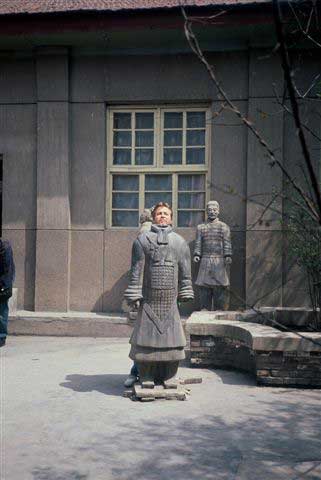
Note the head, the one hand, and the three feet. What does that bring to mind? "The monster created by atoms gone wild! The fly with the head of a man...and the man with the head of a fly!" In other words, Darwin filtered through Watson, Crick, and Leakey. Genetic mutation.
Hmmm, Slade thought. There's plot potential here.

An Alma (or Almas)
The Yeti isn't the only cryptic creature in Asia. "Almas" is the Mongolian word for "wild man." Apart from oral folklore, recorded sightings of the creature go back to the early 1400s, when a Bavarian prisoner of the Mongol Khan saw two Almas in the Tien Shan Mountains of China. Asian apothecaries, he wrote, use them as medicine. Unlike the much larger Yeti, Almas are human-like bipedal creatures, between 5 and 6 1/2 feet tall. Their bodies are covered with reddish-brown hair, but not their hands and faces. Almas have prominent brows, flat noses, and weak chins.
Almas = longevity yang.
Yetis = immortality yang.
For the plot of CUTTHROAT, that was enough. But subsequent evolution discoveries have played into Slade's hands.
CUTTHROAT was published in 1992. If Almas existed as relic hominids, Russian and other scientists theorized they were Neanderthals. Forty thousand years ago, the earth was shared by two hominid species: Neanderthals and us. However, it now appears there may have been four.
In 2003, Flores Man - just three feet tall - was discovered on Flores Island in Indonesia. Because of his diminished height, Homo floresiensis was dubbed the "hobbit."
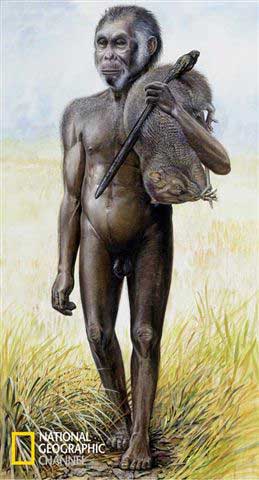
Flores Hobbit in NATIONAL GEOGRAPHIC
In March 2010, the journal NATURE reported that DNA tests on finger bones found in the Denisova Cave in the Altai Mountains of Siberia, China, and Mongolia showed they came from another hominid that lived 40,000 years ago and overlapped with us. That area falls within the realm of the cryptic Almas.

Yangtze River

The Yangtze River flows through central China. A huge dam would soon flood the Three Gorges and submerge the Ghost City of Feng Du, so Slade booked a cruise down the river from Chongqing to Wuhan. A hundred miles into the trip, he stepped ashore to climb Mount Ming to its suspension bridge.
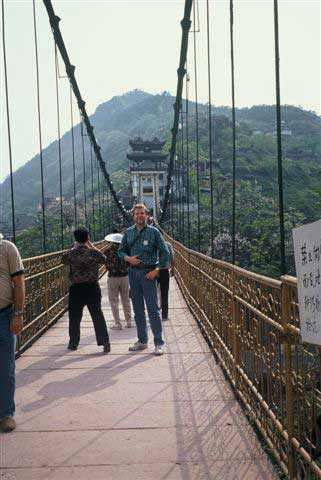
Why is this man smiling? Here's a clue.

Tongue plowing atop Mount Ming
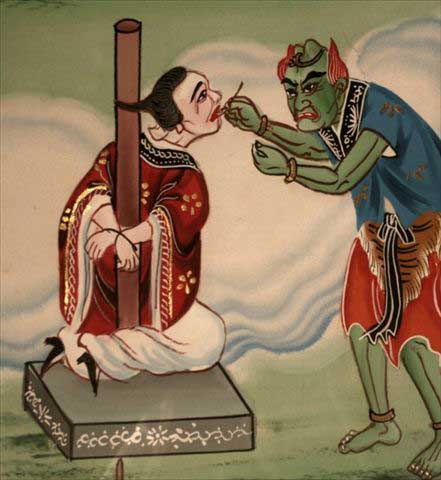
Tongue plowing in hell scroll
The Ghost City climbs the face of Mount Ming. The Taoist temple dates back almost 2,000 years. Feng Du is the place where Chinese ghosts go after death. Will the Lord of Heaven allow the ghost to cross the gold bridge to a position of nobility in the afterlife? Or will the King of Hell doom the ghost to horrific tortures, before the damned is reborn as an animal subspecies?
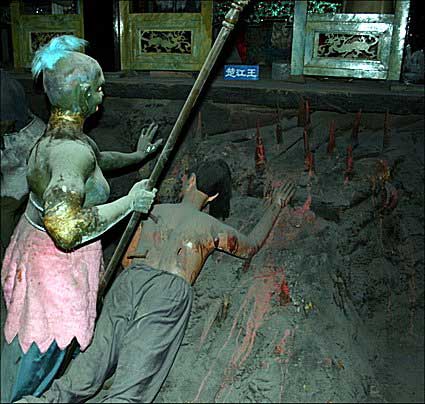
Feng Du's knife hill

Knife hill in hell scroll
Feng Du has comforting vistas like River of Blood, Ghost Torturing Pass, Nothing To Be Done Bridge, and Last Glance At Home Tower. To foresee if his ghost was destined for heaven or hell, Slade underwent a series of tests on the climb up Mount Ming. Could he scale thirty-three steps in a single breath? Could he stand on one foot for thirty seconds on a slippery, rounded rock? The temple at the top displays grisly models of the hellish tortures waiting for those who failed one or more of the tests.
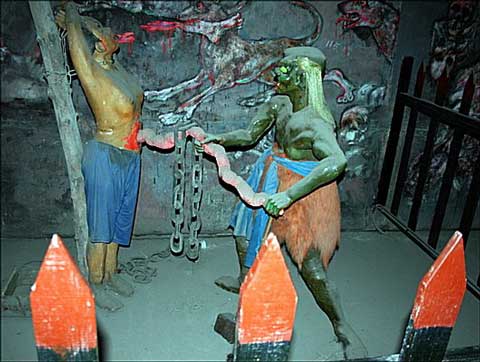
Disemboweling at Feng Du

Hell scroll evisceration
The reason Slade is smiling on the bridge to paradise atop Mount Ming is twofold. First, because he passed the tests and isn't going to hell. And second, because the tortures of Feng Du (reflecting what Ian Fleming told Raymond Chandler) fleshed out CUTTHROAT's ruthless Warlord of the Fankuang Tzu.
Why do the Communist Chinese want him? For the Tien Shan Massacre of 1945.
On the boat with Slade was an American tourist in very poor health. The sickly man's cancer was in remission, but he had lung problems, stomach problems, and other ills. That night, as Slade dreamed peacefully of foretold heaven, a ruckus outside his berth jerked him awake.
China's pollution is notorious. Add to that, dust storms off the Gobi Desert. The choking wretch on his hands and knees was gasping for breath. His gargling was a death rattle. The only medicine man aboard was a Chinese herbalist. As they carried the patient into a berth for traditional healing, the look of fear on his face befitted falling into the clutches of Dr. Fu Manchu.
Soon, however, he emerged under his own steam. Breathing in the deep lungfuls of an aerobics instructor, he announced he hadn't felt this good in years. One hand held a paper packet stuffed with ground powder. The other waved a prescription in Chinese script. He planned to buy the remedy in Hong Kong and lug a suitcaseful back to the States.

Slade snapped this photo of a civet cat in the wildlife yang market of Guangzhou (Canton). Despite the name, it's not a cat, but a nocturnal mammal related to a mongoose. In Chinese medicine, its musky anal scent gland is used in a potion to induce abortion. In "dragon, tiger, and phoenix soup," its meat fights arthritis, stimulates blood flow, and peps up libido. As a winter stew rich in yang, it keeps you warm.
In 2002, eating civet cat meat in southern China allowed its coronavirus to jump species to human beings and cause 2003's SARS epidemic, a respiratory illness that (according to WHO) killed almost 775 people and sickened more than 8,000 around the world.
A decade earlier, CUTTHROAT saw Alma yang cause kuru disease. Known as "laughing sickness," kuru is an incurable, degenerative, spongiform brain disease transmitted as a prion by cannibalizing flesh that's genetically human.
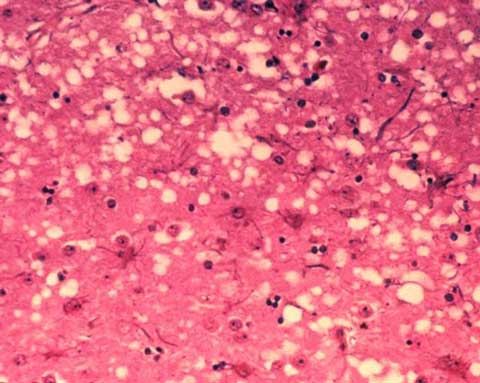
Spongiform holes in brain tissue

That is by far the longest paragraph Slade ever wrote. It attempts to capture the overwhelming effect on him of arriving in Hong Kong, as a relentless succession of sights, sounds, smells, and impressions slam together like boxcars shunting in a railway yard. There was no pause in the chaos, so the paragraph doesn't break.
The years leading up to Britain's handover of its Crown colony to Communist China in 1997 was a time of fear and frenzy. Hong Kong was a case of NIMBY - "not in my back yard" - where the Opium War was allowed to morph into capitalism gone mad, an anything-goes economic monster that would not be stomached at home. Greed unleashed.
Hong Kong Chinese by the tens of thousands were buying their way into Gold Mountain, the long-time name for British Columbia. Before they fled, however, there was money to make, so frantic entrepreneurs were squeezing every last dollar they could out of the dying colony.
The Warlord of the Fankuang Tzu has every reason to run. The Gong An Ju - China's Public Security Bureau - wants him for countless atrocities in the Warlord Era. Kuru disease from Alma yang is eating up his brain. The only cure is Yeti yang, if it can be found. And DeClercq - in his book - has revealed Parker's Journal and the yellow skull.

Japanese edition of CUTTHROAT (yellow skull)
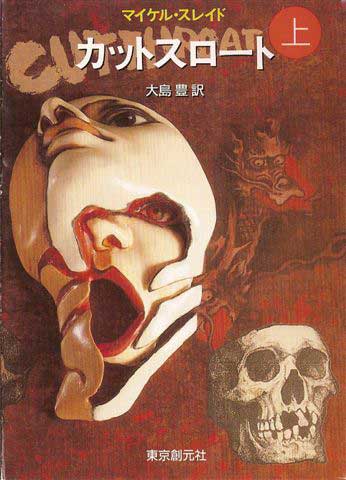
Japanese edition of CUTTHROAT (dragon)
"A thin line separates crime and horror, and in Michael Slade's thrillers, the demarcation vanishes altogether. Clever tales." - Time Out (Britain)
"Not your average cocoa curdler, the writing in CUTTHROAT is crisp, literate, and packed with shocks around every corner." - The Evening Telegraph (Britain)
"CUTTHROAT is an ingenious horror story that spans more than a century. Definitely not to be read when you're alone in a dark room. Full of tension and mystery, with some unforgettable scenes, CUTTHROAT really gives shock value for the money." - Express and Echo (Britain)
"CUTTHROAT is gripping and gruesome. Don't read it when you're alone in the house!" - Wales on Sunday

The Warlord isn't the only killer lured by the yellow skull. Almost half a century has passed since the old man set up in Hong Kong, and subsequent generations have transformed his traditional yang trade into Fankuang Tzu Pharmaceuticals, a high-tech corporate octopus with many tentacles.
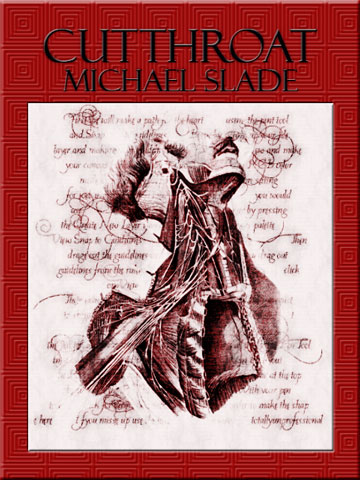
Fankuang Tzu Pharmaceuticals is run by the Warlord's senior grandson and soon-to-be successor, the psychopathic Cutthroat Becoming.

British edition of CUTTHROAT
Cutthroat's genetic obsession is Mitochondrial Eve, and the implication of "atoms gone wild" for human longevity.

NEWSWEEK: January 11, 1988
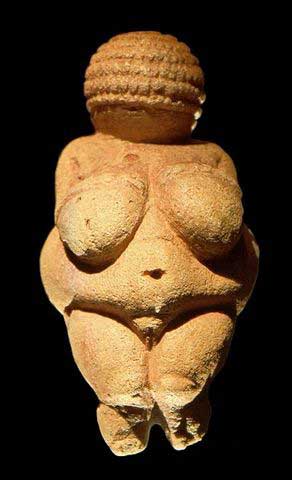
Venus of Willendorf - possibly a fertility symbol - carved about 25,000 years ago
Mitochondrial Eve was the Most Recent Common matrilineal Ancestor (MRCA) from whom all humans living today are descended. In other words, every living person inherited her mitochondrial DNA (mtDNA). If there was a defect - a mutation - in her genes, we've all got it.
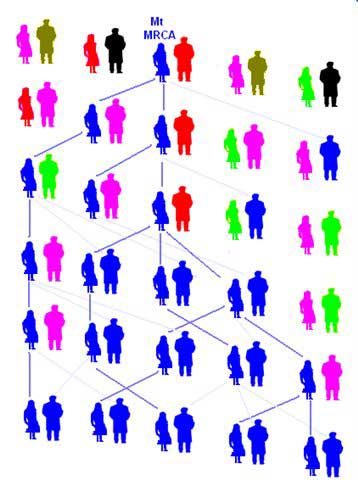
Descent of mitochondrial DNA
Mitochondrial Eve lived about 200,000 years ago, most likely in East Africa, when Homo sapiens sapiens evolved as a species separate from other hominids. Her descendants spread out from Africa and replaced other human species around the world...unless relic hominds - who left Africa earlier without Eve's defective gene - live on in wild places.

Mitochondrial Eve's descendants leave Africa
The time has come for Cutthroat, the Warlord, and Fankuang Tzu Pharmaceuticals to get out of Dodge. Bygone China and teetering Hong Kong are the past. The future is Gold Mountain. The yellow skull offers hope that Yeti yang survives there. First, the deadly emigrants will launch an expedition up Windigo Mountain in the Great Divide that links that cannibal monster with the man-eating Sasquatch. That's where the Mad Mountie and Iron-child vanished in 1897, shortly before the peak fractured into an off-bounds avalanche hazard.
The only obstacle thwarting them is an immigration problem, so CUTTHROAT begins with this:

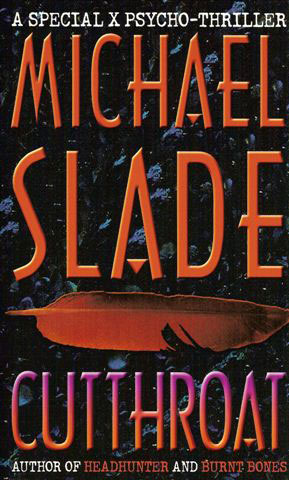
Canadian edition of CUTTHROAT
Reaction from Gold Mountain:
"One of the best books I've found recently is CUTTHROAT. It's the joint effort of two criminal lawyers who've taken all the best stories they've heard in the barristers' changing room and added more than a few drops of their own magic potion. What they came up with was a jet-fueled roller-coaster ride that starts with Custer's Last Stand and the murders of a couple of Canadian judges, goes back to the origins of Man, and forward to a plot by an Asian drug lord to achieve immortality and world domination. They somehow manage to make the improbable seem possible enough. It's an outrageous, good read." - The Province
"Cannibalism, mythic and real, claws at the dark heart of Michael Slade." - Vancouver Magazine
"Unspeakable, vile things happen when Michael Slade prowls the rain-slicked streets of Vancouver. For those unfamiliar with his work, Slade loves terrorizing people who think themselves unscareable. CUTTHROAT pins down and then gleefully dissects topics such as evolution, the legal system (a high-profile judge is blown away in the novel's opening scene), xenophobia, and Asian gangs. A Hong Kong pharmaceuticals conglomerate with underworld connections is looking to expand to the West. The head of that conglomerate is willing to kill anyone standing in his way. " - The Vancouver Courier
"Realism, tension, and good, honest frights. The thrills come every few pages. Through the shadows of the past to modern-day China and Hong Kong, the Mounties hunt a twisted killer while the search is on for eternal youth. For tension, there's Slade's No. 1 rule: no character is safe from death or insanity, not even the leads." - The Canadian Press
"Slade takes readers on a roller-coaster ride in this anthropological horror/adventure set in Vancouver, San Francisco, and Hong Kong. It combines a strange mix of characters and events: Colonel Custer at Little Bighorn, Charles Darwin, Bigfoot, Asian gangs, and prehistoric apes. It deals with the harrowing search for the fountain of youth and the timely issue of xenophobia. Slade builds tension and terror to make his story as thrilling as possible." - North Shore News

Michael Slade: the collaborators on CUTTHROAT
(photo by Oraf)















